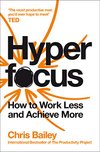
Saved by CodeMacLife and
Hyperfocus: How to Work Less to Achieve More

Saved by CodeMacLife and
The more aversive a task, the more important it is that we enter into a hyperfocused state so we can work on the task with intention.
To hyperfocus, you must 1. choose a productive or meaningful object of attention; 2. eliminate as many external and internal distractions as you can; 3. focus on that chosen object of attention; and 4. continually draw your focus back to that one object of attention.
set intentions more often, modify your environment to be less distracting, overcome the mental resistance you have to certain tasks, eliminate distractions before they derail you, and clear the distractions inside your own head.
hippocampus
basal ganglia,
It doesn’t matter how busy we are if that busyness doesn’t lead us to accomplish anything of importance. Productivity is not about cramming more into our days but about doing the right thing in each moment.
productivity means accomplishing what we intend to.
The state of your attentional space determines the state of your life. When your attentional space is overwhelmed, you, in turn, feel overwhelmed. When your attentional space is clear, you also feel clear. The tidier you keep your attentional space, the more clearly you think.
what you intend to accomplish and what you’re currently doing.